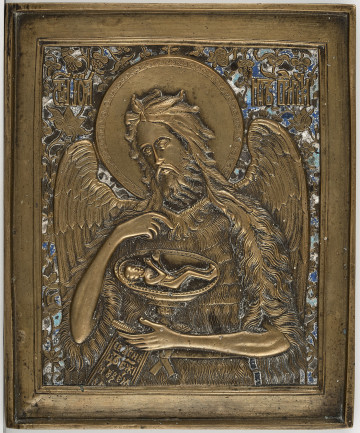
St. John the Baptist
20th century
Castle Museum in Łańcut
Part of the collection: Icons
Mother of God Hodegetria of Smolensk icon, Russia 19th-20th c. The Smolensk Mother of God icon is one of the most popular depictions of Hodegetria in Rus. In the Christian tradition, the creation of the three oldest depictions of the Mother of God is attributed to St. Luke. He was a disciple of St. Paul the Apostle and his companion on missionary journeys, as well as the author of the third Gospel, dedicated to "the most excellent Theophilus" or, as biblical scholars explain, to an unnamed friend of God, 'Theo phile', a Roman official in Antiochia, who converted to Christianity. Together with the text of the Gospel, St. Luke was to send an image of the Mother of God which returned to Jerusalem after the death of 'Theophilus'. Empress Eudocia, wife of Theodosius II, having found the icon in Jerusalem in 439, brought it to Constantinople and placed it in the Ton Hodigon (Hodegon) monastic church, known as the Church of Guides. Because of the church's name, the depiction of Mother of God Hodegetria began to be called 'one who shows the way', meaning she was the Guide to Christ. The depiction became a sacred object for the Empire; it was only destroyed by the Turks, who captured Constantinople in 1453. Numerous copies of the image which spread through Christian territories contributed to the popularisation of the depiction of Mother of God Hodegetria with the Child. The Mother of God, facing the viewer and depicted in full or in half-figure, with her head inclined or turned towards the Child, points at him with her hand. Christ usually sits on His Mother's left arm, holds a scroll or a book, and gives a blessing with his right hand. Variants of this depiction differ between individual icons, which were given their own names denoting their place of origin, revelation, or cult, or the circumstances related to them. One of them is the S.12677MŁ icon, known from the original Mother of God Hodegetria, called the Hodegetria of Smolensk, which came to Rus in the middle of the 11th c., as described under S.12777MŁ. Teresa Bagińska-Żurawska https://orcid.org/0000-0002-9243-3967
Other names
Smolensk Mother of God
Dimensions
height: 17.8 cm, width: 1.3 cm
Object type
Icons
Technique
tempera
Material
tempera, wood
Creation time / dating
Creation / finding place
Owner
Castle Museum in Łańcut
Identification number
Location / status

20th century
Castle Museum in Łańcut

19th (?) century
Castle Museum in Łańcut

1800 — 1850
Castle Museum in Łańcut
DISCOVER this TOPIC
Museum of King Jan III's Palace at Wilanów
DISCOVER this PATH
Educational path